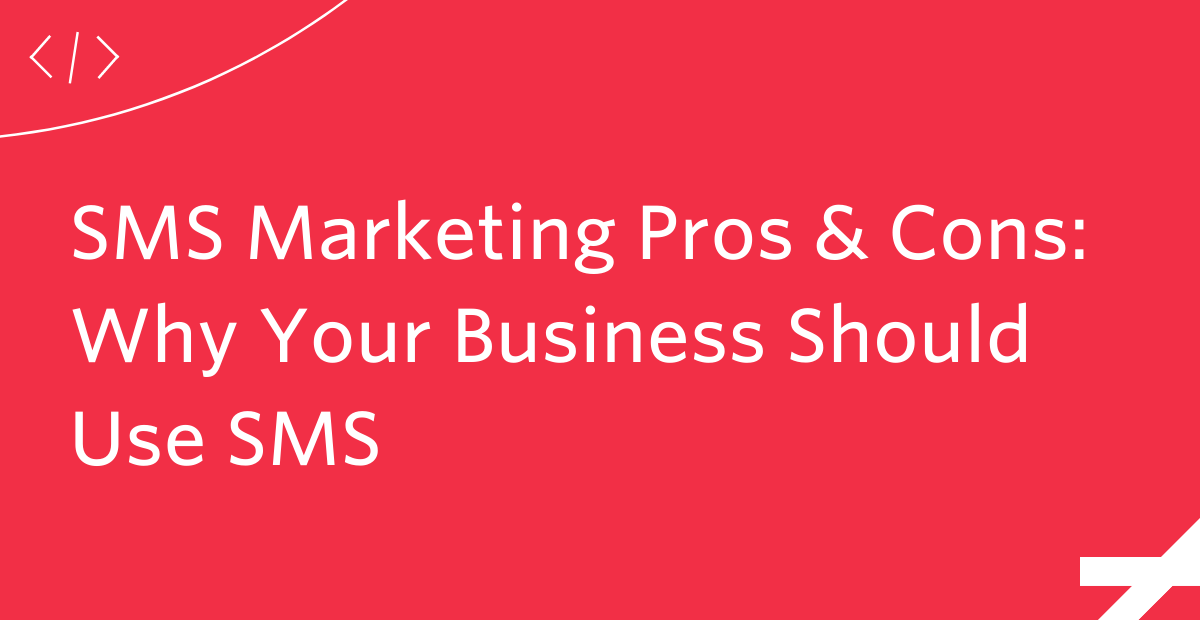SMS Marketing Pros & Cons: Why Your Business Should Use SMS
Time to read: 4 minutes

SMS marketing is the next messaging frontier. When it comes to communication between customers and businesses, email and SMS are the most preferred channels. In fact, more than 39% of consumers prefer to receive SMS messages from companies—that's more than for mobile apps, social media channels, messaging apps, or phone calls.
Yet, SMS is an untapped channel. While 83% of people received an SMS message from a business in 2020, only 70% of brands used the medium to communicate with customers or employees.
If you're one of the businesses yet to embrace SMS marketing, this article is for you.
Below, we'll walk you through the pros and cons you need to consider before adopting an SMS marketing strategy. First, let's look at why you should use SMS for marketing. Then, we'll briefly touch on different ways your business can use text marketing.
Advantages of SMS marketing for businesses
Let's look at a few data-backed reasons why SMS marketing is effective for businesses:
- People open their texts: General SMS messages get a 98% open rate, while SMS marketing has an average 82% open rate. Customers take action, too—text messages that include a URL achieve an average 36% click-through rate (CTR).
- Consumers want SMS: While 91% of consumers are interested in signing up for texts from brands, 55% already have. Customers want to use SMS for shopping, too, which makes SMS marketing a natural solution. In 2020, over 66% of shoppers signed up to receive texts from more businesses than they did in 2019.
- SMS is an opt-in channel: Unlike sponsored content or pay-per-click (PPC) advertisements, SMS is a channel customers ask to receive.
- Consumers consider SMS marketing messages valuable: While most customers value reminders and update texts the most, discounts are the third most valuable type of SMS message.
Your customers want to communicate with your business via SMS. It's no longer a nice-to-have marketing channel—it's a need to have.
Pros and cons of SMS marketing
SMS is a channel your business should be using, but that doesn't mean it's perfect. It has its benefits and downfalls—and we're going to detail both below.
Pros of SMS marketing
- High open rate: SMS has a 98% open rate. Compared to email's 14.5%, that's quite high. When you send your customers a text message, you can almost guarantee they'll open it.
- Timely: Within 90 seconds of receiving it, 83% of millennials open a text. If you have an urgent message or promotion you want to get out, a text message is the fastest, most reliable way to do it.
- Personalized: SMS is an intimate form of communication, and according to Twilio's State of Customer Engagement 2022 report, ninety-eight percent of companies say that personalization increases customer engagement and 83% of consumers agree. Whereas SMS is a terrific channel, be sure to respect your customers' desires to ensure your promotional messages do not become intrusive.
- Cost-effective: With Twilio, sending or receiving text messages start at just $0.0075—that's a lot cheaper than any ad click. And with the 36% CTR we mentioned before, you know your customers aren't letting your messages go to waste. Want to see what it's worth to your business? Try our text marketing ROI calculator to see for yourself.
- Permission-based: When you send a text to your customers, it's because they asked for it—literally. They gave you their phone number and explicitly permitted you to send them messages. When they receive a text from you, it's almost always a message they wanted—if not, they'll unsubscribe.
- Engaging: Customers can't engage with PPC ads, billboards, or TV commercials. With email and text, they can. Your customer can follow up and ask about a specific campaign or promotion, and you can immediately turn the conversation into a sales-building opportunity.
Cons of SMS marketing
- Message length limit: Text messages are limited to 160 characters. If you want them to be longer, you'll have to pay for the additional messages it takes to deliver the extra characters. Plus, customers expect short and sweet texts. That's the nature of the medium. If you can’t condense your marketing message into 160 characters, it's probably better off as an email or social media post.
- Smaller lists: Another email account may be easy to create, but it's not quite so simple (or cheap) to purchase another phone number. That's one of many reasons consumers are more protective over their mobile contact information. Since consumers demand more SMS communication from businesses, don't expect your SMS list to be as large as your email list.
- Less frequency: While 56% of consumers receive anywhere from 25 to more than 100 emails per day, the same isn't true for texts—the average person only sends around 15 messages every day. You won't be able to message your SMS list as often as you send emails or post on Instagram.
- Extra channel to manage: Text message marketing isn't just something you can jump into willy-nilly. It's a channel you'll need to manage thoughtfully and proactively. You need to be consistent, responsive, and strategic. It's another channel to manage and will take time and resources.
How to use SMS marketing for your business
Curious how your business could use SMS marketing to engage with customers? There are plenty of ways. Here are a few of the most common ways businesses use SMS marketing:
- Coupons and discounts: Offer exclusive discounts and flash sales to your SMS subscribers.
- Updates: Let your customers know about changing store hours or new product launches.
- Services: Provide customer support, tutorials, or onboarding through 1:1 text messages.
- Contests and sweepstakes: Host a giveaway to encourage new subscribers to join your SMS list.
- Polls: Learn more about your customers and give them a chance to voice their opinions.
- Newsletters: Inform your audience about new content or deals on a weekly basis with quick SMS newsletters.
Try using SMS marketing
Don't just take our word for it—see for yourself. Sign up for a free Twilio account to get started with SMS marketing.
You can build personalized experiences tailored to your customers' needs using Twilio Studio, our easy-to-use drag-and-drop visual builder. It lets you start conversations, handle responses, and create intuitive workflows—all to improve the customer experience.
Related Posts
Related Resources
Twilio Docs
From APIs to SDKs to sample apps
API reference documentation, SDKs, helper libraries, quickstarts, and tutorials for your language and platform.
Resource Center
The latest ebooks, industry reports, and webinars
Learn from customer engagement experts to improve your own communication.
Ahoy
Twilio's developer community hub
Best practices, code samples, and inspiration to build communications and digital engagement experiences.

